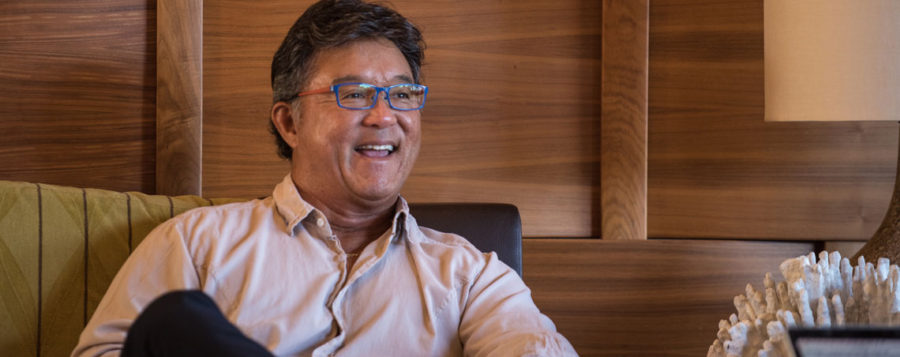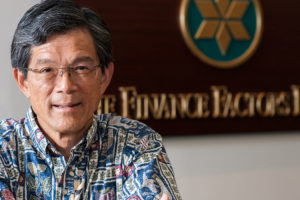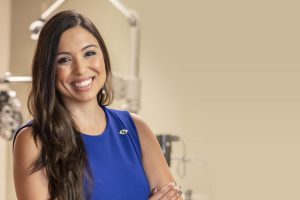Guy Akasaki is a communicator. With a joke or two, a contagious laugh and a warm smile, he serves as the CEO and president of Commercial Roofing & Waterproofing Hawaii and several other businesses in Hawai‘i and across the Pacific Rim. Through humility, integrity and perseverance, Akasaki has been able to navigate the push and pull of economic cycles across nations to drive success in his endeavors and for his employees. By analyzing past trends to stay ahead of the curve, he has expanded his businesses into multiple markets to solve problems for businesses, government entities and local homeowners.
Tell us about your career path.
To start, I’m a failed architect. From junior high school all the way into college, Frank Lloyd Wright was my inspiration. But as soon as I got into college, I saw how my friends who had graduated years before me were [doing time as architecture] interns, and I thought that was junk.
So I went into tourism industry management and became a night auditor for the Outrigger. I loved it because I worked the graveyard shift, so I could grab my surfboard and go surf in the morning. We became one of the most efficient night auditors in town. We finished our work in half the time when it came time to balancing revenues.
Later I worked for a roofing contractor. I began to find that it used a lot of my skillsets because it was construction, programs, topography, engineering. I did that for about 14 years.
There came a point when the economy was turning down that the owner wanted to get out. I talked to other key people about buying out the company as part of an employee stock ownership plan, where the employees can buy out the employer. The owner got excited and said, “Let’s proceed.” But when it came time for the transition, the owner said he wasn’t leaving.
I tendered my resignation with no intention of resigning at a time when the economy was really bad. If you’re going to do something like that, you’re going to have things set up, a job set up, things planned out. But I thought it was really important that when the resignation period occurred, it was done with the right motive.
I think commitment, honesty and integrity are key to being successful in business, so I told him that I wouldn’t compete with him for one year if I ever got back into the roofing industry, even though I didn’t have a non-compete.
I started to look into different small businesses and migrated back to commercial roofing, but just repairs. Enough with working with hundreds of guys in the field. So I started to do that and it was really tough. I couldn’t go to any of the clients we had before. It was brand-new people.
Hawaiian Dredging called me up and told me they had been trying to find me. They had heard all the comments and criticism about the way I had left but didn’t believe it. I told them I couldn’t do the job they were offering because I didn’t have the funding or the equipment. They said they would take care of all the equipment, provide the funding and we would split the profits. I couldn’t believe it.
But then I remembered what I said about not competing with the other roofing contractor. When I told him I had to step away, he said, “What, you been drinking?” But I made a commitment.
Three weeks later I had another contractor that I knew from years ago contact me. He had a lot of money and was wondering what kind of company he could start. We talked and he said, “Great, here’s the check, you go ahead and start it. You can set it up however you want.”
But this guy was all about the money, and I know how that dictates the direction. Until that money is paid back, it’s going to be all about him and money. The small voice in me wondered how I could fulfill my purpose and destiny if I’m obligated to take care of the debtor. It was really tough, but I told him I had to step away.
So then I started a small little repair crew. Our warehouse was an eight-by-eight-by-seven storage unit and our fleet of vehicles was an old 1986 Toyota pickup and a Nissan that was about ready to fall apart. Whenever we did advertising, we’d superimpose the photo in front of a few big trucks behind us. That was our humble beginnings as Commercial Roofing.
As we moved into the last quarter of the year, I thought we were down, like, $600,000. We would have lost our house, the kids would have had to pull out of school. It was pretty traumatic at that period of time. It turns out we actually made it—made a little money—but there was some real soul searching that occurred.
The second year, we opened up a company in the Philippines, where we did engineering and consulting work for the military in Subic Bay. Then, when Honolulu Roofing went under, I picked up the name and held onto it until all the rubbish settled. I resurrected it because it had a lot of good work attached to the name.
Shortly after that, we started Allied Pacific Builders. We did a lot of building renovations with the military and the Navy. After that, things started to happen in Guam. We bought out the assets of another company and started up Allied Pacific Builders Guam to be able to tack on all the work with the movement of the Marines from Okinawa to Guam.
One of the reasons I wanted to make sure we had a presence in Guam is because Guam is a hub zone. In Hawai‘i, hub zone designation means you’re in a disadvantaged area with a certain number of disadvantaged employees. It’s a moving target here, but if you’re in a hub zone, you get to bid on a lot of set-aside work. By headquartering this company in Guam, everything we do in Hawai‘i is considered hub zone, so we don’t have to move around like a rabbit.
Shortly after that, we started Green Path Technologies because we were working with the office of labor research and the Marine Corps Experimentation Center. We did research and development in renewable energy. We did non-glass photovoltaic modules for military operations in conflict and High Availability Disaster Recovery, humanitarian assistance and disaster relief so you can charge phones and have energy and lighting in adverse conditions. Then we got into developing building-integrated photovoltaics, where the PV is a part of the roofing or building envelope.
When it comes to commercial properties, everything is based on valuation of the asset. That valuation is determined by income stream. What is the one floor that generates absolutely no income for your commercial building? The roof. And on a commercial building, what is the one losing opportunity? Your building envelope has a depreciation period of 37 and a half years, but your roof won’t last longer than 20 to 25 years. When you put PV on the roof, you can write that off in five years. Tax credits and subsidies allow the owner to take pre-tax dollar use of this benefit. Now the roof is generating income and adds to the valuation of that asset. The tax credit and subsidies made a good marriage between roofing and PV. We were already doing non-glass laminates when the PV revolution came into play. We thought, “Wow, this is perfect, we’re already doing roofing.” That’s where the commercial brokerage company came in—we started Pacific Properties Group to do commercial brokerage, property management, real estate and leasing.
We also buy kilowatt-hours and actually do the engineering, procurement and contracting of PV systems. We’re also investors. We’ll put PV on nonprofits—they pay no money, but we generate income from them. It’s a win-win-win. They get a discounted energy rate that’s far cheaper than what they have to pay currently, and we have an income stream for a set period. It’s almost like a mortgage. That’s another form of business that we do through Green Path Technologies.
Within some of the companies, we are moving into areas of specificity. At Green Path, we’re moving into thermodynamics and air conditioning. We introduced technology where you harvest the power of the sun directly in the air conditioner. That way, you don’t need utility approval and you still get tax credits. By putting a solar-powered air conditioner in place of the one you’re using, you’re giving yourself additional capacity on your original net energy metering contract for all your energy consumption. If you want to add an electric car, you can run this system outside of that. And the utility endorses it. We also introduced solar PV as part of the heat-abatement effort at local schools. During the day when school is going on, power is sent to the air conditioners directly, without going back to the grid.
It’s been a journey of 23 years. I would never have imagined we would get to where we are today. We’re in China, where some of these technologies are patented. We just came back from Vietnam, and we have different technologies in the Philippines—composite building systems in some of the high rises. And on the roofing side, we’re moving into a lot of different technologies as well. We actually introduced a product from Israel, a water-based urethane. It’s non-toxic, and you don’t need protective equipment to apply it. It’s simple to apply, with a high resilience and high solar reflectance.
There are technologies even in the old technologies of roofing, it’s just being aware of all the data points on the horizon. You can do the things you do normally, or you can try to improve it. It’s thinking outside the box and getting your people to step into that type of thinking.
So all the companies we set up, I frame it so they’re aligned with the core values of what we believe. A lot of what I have today is because of honesty, integrity and commitment from the old days.
What advice do you have for young professionals?
When you’re young and you start a business, if you’re not really clear on where you want to be and who you are, life has so many distractions that can take you off course. Know who you are. Know your purpose. Know your destiny. Know when you succeed and know absolutely when you fail. Then you’re not a failure. It’s just a step in the process to fulfill that purpose and destiny in your life. Unfortunately, time passes quickly.
What is the motivation to find business opportunities overseas?
A lot of times, when you start a business or capitalize on an opportunity, you look at the things right in front of your face. But you really have to look at history and trends. You have to pull from your experiences and yield to your integrity, honesty, commitment and determination. You have to have the foresight not just to stick it out, but to understand what is happening and why.
One thing that always works is in times of feast, plan for times of famine. And in times of famine, plan for times of feast. A lot of times in that famine period, people just hunker down. But if you’re smart, that famine period is the time when you start spending money to build. When things are going good, start putting resources on the side. When the famine comes, you’re able to maintain your current infrastructure and talent to weather the tough times. When the cycle picks up again, you’re ready to rock and roll. You don’t want cut people, you want to retain them so that they feel safe. From a company standpoint, you’re already positioning yourself for the next road. That same thing happens globally.
What is your role on the Hawai‘i State Contractors License Board and what other types of community service do you participate in?
For eight years I served on the Hawai‘i State Contractor’s License Board, and I was the chairman for the last four. It’s a lot of commitment, but it was very exciting because it gave me an eye into my industry. It gave me very good perspective, looking at it from the standpoint of the public at large.
I’m also on the advisory board for the Salvation Army, the Friends of Hawaii Charities for the Sony Open and the Hawaii Children’s Discovery Center board. I’m currently working with the Salvation Army to do a school supply drive. We’re going to get a lot of our company, affiliate companies and vendors to pick up school supplies for kids at disadvantaged schools.




